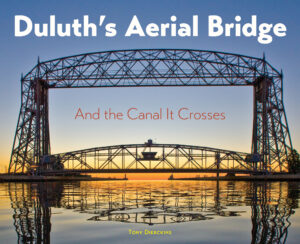Renovations to the Aerial Lift Bridge 1931–2000

Bridge operator (and, later, supervisor) Don Bowan greases one of the lift bridge’s massive sheaves (Image: Larry Lyons)
Much of the aerial bridge’s history involves maintenance, renovations, and adaptations designed to improve the bridge’s performance and keep it running smoothly and safely. When the lift bridge first went to work, operators had trouble hearing incoming vessels signal to request a bridge lift. In 1931 the city installed a “mechanical ear” tower on the north pier, just west of the lighthouse. Microphones atop a tower could pick up a ship’s whistle half a mile away on a stormy night. Radio signals transferred the sound back to a receiver in the pilot house for monitoring. (The Coast Guard also maintained a radio tower atop the South Pier from the 1920s until 1985.)
After nearly twenty years of turning, the bridge’s gears were first replaced in 1949. Two years later operators installed a new 153-cell battery system beneath the South Pier approach. The new batteries were safer, took less time to charge, and provided more horse power. From mid December 1952 until the end of February the bridge was not raised as its bearings were replaced and workers began repainting the entire bridge.
In 1955, workers used a “special steel fabricated surfacing” to replace the bridge’s worn road deck, which still carried trolley tracks even though Duluth’s street car system had shut down in 1939. Later that summer the paint job started in 1952 was finally finished. The 1932 mechanical ear came down in 1960, replaced by a Raytheon Model 1500 Radar Radio Positioning Unit. Now, instead of waiting to hear a horn blast or using binoculars to scan for arrivals, the bridge operators would be alerted to a ship’s approach by a blip on a screen. That same year chief operator Al Hass replaced the tap water in the bridge’s batteries with distilled water, which nearly tripled their lifespan.
In May 1964 the bridge’s four trumpet-shaped brass horns that had greeted ships since 1930 were replaced after sounding an estimated 500,000 times. The new horns—two sets of them—were similar to those used on diesel locomotives; one faced lakeward and the other toward the bay. A set of synchronized lights flashed in time with the horns. The bridge was getting safer all the time for both the ships that passed beneath it and those who used it to cross the canal. In the early 1970s the bridge was painted silver, part of a program that included upgrading the batteries and installing a new emergency engine to replace the back-up gasoline engines.
The bridge’s biggest renovation project, a refitting of the its mechanical systems, came in 1986. The overhauls essentially changed how the bridge operated, and you can read about it and see diagrams here.

Workers replace a sheave in 1999. [image: Duluth Shipping News]
Between 20028 and 2011 the lift span and both towers were repainted, but lack of state funding has delayed the upper truss and underside of the lift span. Workers replaced the lifting cables in 2016, and in 2021 the bridge was updated with fiber optics and a new camera system.










